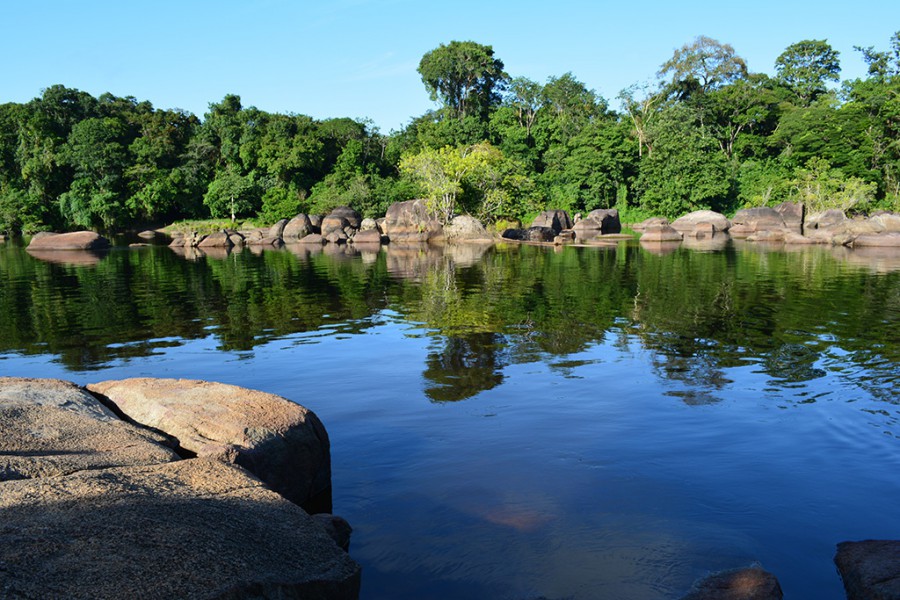
by DGR Colorado Plateau | Nov 6, 2015 | Mining & Drilling
By Apoorva Joshi / Mongabay
This is the second in a two-part series on gold mining in Suriname. Read the first part.
- Gold mining in the small South American country grew by 893 percent between 2000 and 2014.
- Much of the small-scale and industrial gold mining in Suriname is taking place within the boundaries of the traditional territories of local communities.
- With gold prices continuing to rise overall despite recent drops and Suriname’s political economy deeply entrenched in resource extraction, conservationists worry mining expansion will be hard to stop.
High gold prices combined with lax land use regulations have led to an explosion in mining in Suriname. A recent report by the Amazon Conservation Team (ACT) finds that gold mining in the small South American country grew by 893 percent between 2000 and 2014, and is threatening the health and ways of life of many communities in the region.
Much of the small-scale and industrial gold mining in Suriname is taking place within the boundaries of the traditional territories of the Maroons – descendants of formerly enslaved people of African heritage who escaped from plantations during Dutch colonial rule and established thriving communities in the country’s hinterlands after successfully fighting for their freedom.
Suriname’s six main Maroon communities all reside along rivers leading upstream deep into the rainforest, the report says. The majority of Maroons live in the central-eastern part of the country – where the mineral-rich Greenstone Belt and gold deposits are located. Through statistical analysis, the ACT discovered that encroachment of gold mining is significantly more severe within Maroon territories than outside of them. The team writes that only one Maroon community far from the Greenstone Belt is currently not seeing any gold mining on their lands.
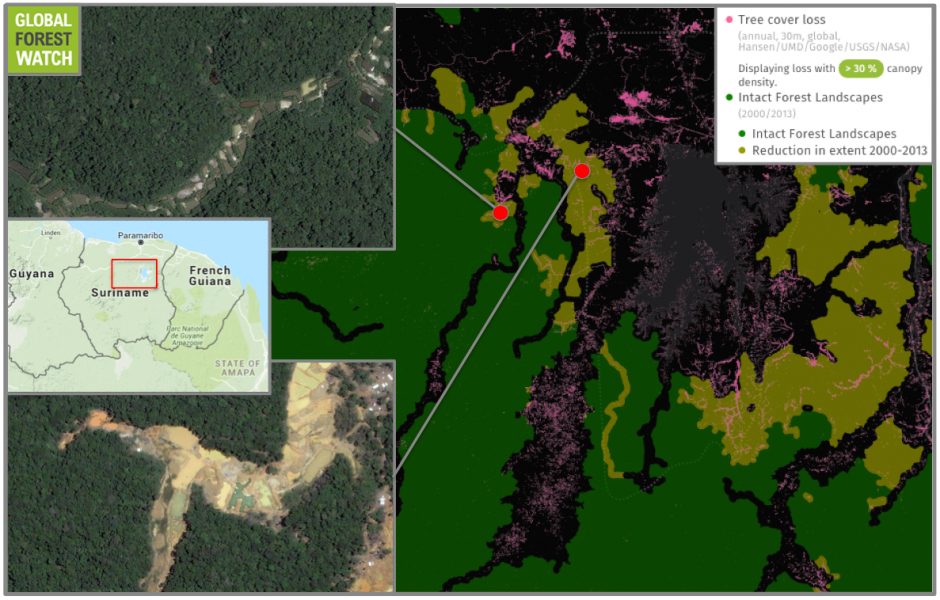
Suriname boasts large tracts of intact forest landscapes (IFLs), which are continuous, undisturbed areas of primary forest. However, Global Forest Watch shows significant IFL degradation, with the country experiencing nearly 17,000 hectares of tree cover loss in its IFLs between 2001 and 2014. Much of this is happening in areas with gold mining activity.

Mining extent (red) in Maroon-occupied areas. Image courtesy of the ACT.
For some Maroon groups, small-scale gold mining has become a major component of their landscape and their daily lives. In many of their villages – particularly in Paramaka, Aukan and Matawai communities – villagers have become economically dependent on gold mining. Anthropologist Marieke Heemskerk has shown that in some Maroon villages, 70 to 80 percent of households get their regular income from family members working in gold mines. Villagers with informal concessions are able to collect fees from the garimpeiros – the Brazilian miners – and others working on their lands, and some have become quite wealthy as a result.
The Matawai Maroons who live along the Saramacca River in central Suriname, are among the smallest of the Maroon communities in terms of population. Their territory covers about 560,000 hectares and many of their villages are among the most remote and least-known in the country. Consequently, the Saramacca River, the surrounding ecosystem and the villages themselves remained relatively quiet and peaceful while other Maroon communities were contending with the pressures of inland colonization and resource extraction.
The northern portion of the Matawai territory, however, is located in the reaches of the Greenstone Belt. Being close to populated settlements, they are easily accessible via roads. This has allowed rapid expansion, with a number of the northern Matawai villages located at ground-zero for Suriname gold mining.
“According to our calculations derived from deforestation data, 81.51% of all deforestation in the Matawai territory is due to gold mining,” the report says.
Community members from the Matawai villages of Boslanti and Vertrouw learning to use GPS technology in a village mapping exercise. Photo courtesy of the ACT.Community members from the Matawai villages of Boslanti and Vertrouw learning to use GPS technology in a village mapping exercise. Photo courtesy of the ACT.
Four Matawai villages – Nyun Jakobkondre, Balen, Misalibi, and Bilawatra have been particularly impacted by the large gold mines that encircle them. In fact, much of the small-scale mining in the region is done by Maroons themselves, which is threatening their traditional livelihoods of hunting, fishing, woodworking, etc.
“As more Maroons in the Matawai community and elsewhere are becoming dependent on partaking in mining for household income, these and other local practices are eroding,” said Rudo Kemper, GIS and Web Development Coordinator for the ACT. “Many of the Matawai youth in particular are no longer as interested in traditional activities, as they know that there are lucrative profits to be made working in the mines.”
To make matters worse, mining activities has polluted waterways with mercury, which is used to separate the gold ore from sediment. Mercury can act as a neurotoxin, and has contaminated river fish, which are no longer safe to eat. Arable land is also threatened. According to Kemper, “in areas like Nyun Jakobkondre, the gold mining is taking place so close to the village that fertile land for cultivation is becoming scarcer.”
Nieuw Koffiekamp, a village settled by Maroons after it was relocated because of floods, is now located right in the middle of one of the most prosperous and mineral-rich veins of the Greenstone Belt. Known as Gros Rosebel, the area was one of the first industrial mining concessions in Suriname. Villagers have been using the area for sustainable livelihoods for generations, but the ACT report alleges they were neither consulted with nor informed about the concession. Years later, the government set up a task force dedicated to relocating the village once more. The village continues to fight for its existence, despite being literally fenced in by gold mining activity. Community members argue they have the right to extract resources from their own land and thus participate in small-scale gold mining.
Even Brownsberg Nature Park, a 14,000-hectare reserve and popular tourist destination, hasn’t been spared from the clutches of mining. From early on, gold miners have been active within its boundaries, where an estimated 924 hectares of primary forest has been lost to gold mining. In 2012, deforestation in the park reached an all-time high, with 200 hectares of forest cleared. In that same year, public awareness about mining inside Brownsberg began increasing when WWF–Guianas published a report with aerial photography of the damage to the park. “Since then,” Kemper said, “the rates of small-scale mining in the boundaries of the park have dropped somewhat, although deforestation caused by mining in the park [continues] to expand.”
Partially republished with permission of Mongabay. Read the full article, Gold mining boom threatens communities in Suriname

by DGR Colorado Plateau | Nov 4, 2015 | Biodiversity & Habitat Destruction, Mining & Drilling
By Apoorva Joshi / Mongabay
This is the first in a two-part series on gold mining in Suriname. Read the second part.
- High gold prices are leading to an increase in mining activity.
- Mining activities threaten Suriname’s primary forests, some of the most-intact in South America.
- Mercury released from the mining process can be toxic, and is showing up in human population centers far downstream.
Record high gold prices over much of the past decade have triggered a massive gold rush across much of the Amazon basin, resulting in the destruction of thousands of hectares of pristine rainforest and the contamination of major rivers with toxic heavy metals. A newly released report published by the Amazon Conservation Team titled “Amazon Gold Rush: Gold Mining in Suriname” explores the rapid expansion and impacts of gold mining in Suriname through cartography and digital storytelling.
It finds that from 2000 to 2014, the extent of gold mining in the South American country increased by 893 percent.
While the Amazon rainforests of Brazil and Peru are well-known, Suriname’s vast and ancient rainforests remain one of the world’s best-kept natural secrets, according to the online report. But demand for the age-old elemental metal threatens to destroy them.
“According to our calculations, deforestation caused by gold mining has been growing steadily since the turn of the century and rapidly in the past five years,” GIS and Web Development Coordinator at the Amazon Conservation Team, Rudo Kemper told mongabay.com. The average rate of deforestation since 2000 is close to 3,000 hectares per year, but in 2014 an estimated 5,712 hectares of forest cover was lost to gold mining, he said. The REDD+ for the Guiana Shield regional collaborative study on gold mining shows similar trends, reporting a near-doubling (97 percent increase) of deforestation from 2008 to 2014 and attributing a total of 53,668 hectares of deforestation to gold mining in 2014.

Compared to many other South American countries, Suriname still holds much of its forest cover. According to Global Forest Watch, Suriname lost 0.7 percent of its tree cover from 2001 through 2014 – a small proportion compared to Brazil’s 6.9 percent. However, Suriname’s intact forest landscapes – large, continuous areas of primary forest – do show degradation since 2000.
The Guiana Shield, as Kemper puts it, is one of three cratons of the South American tectonic plate. “It is a tropical rainforest region covered with unique table-top mountains called tepuis,” he said. “It has the largest expanse of undisturbed tropical rainforest in the world, and one of the highest rates of biodiversity.” Suriname is among the most forested countries in the world, as the report highlights. In 2012, 95 percent of the country’s entire area was classified as forest. Globally surpassed only by its neighbor French Guiana, Suriname’s pristine rainforest harbors numerous unique species of fauna like the Guianan cock-of-the-rock (Rupicola rupicola), the famous blue poison dart frog (Dendrobates tinctorius), the red-faced spider monkey (Ateles paniscus), and the pale-throated sloth (Bradypus tridactylus). Jaguars, tapirs, and giant anteaters also call the region home. The mineral-rich Greenstone Belt region, where most of the gold mining in Suriname takes place, is primarily composed of the forested highlands of the Guiana Shield. Conservationists worry that deforestation caused by rapidly expanding gold mining activities is negatively impacting the habitat of many unique species.
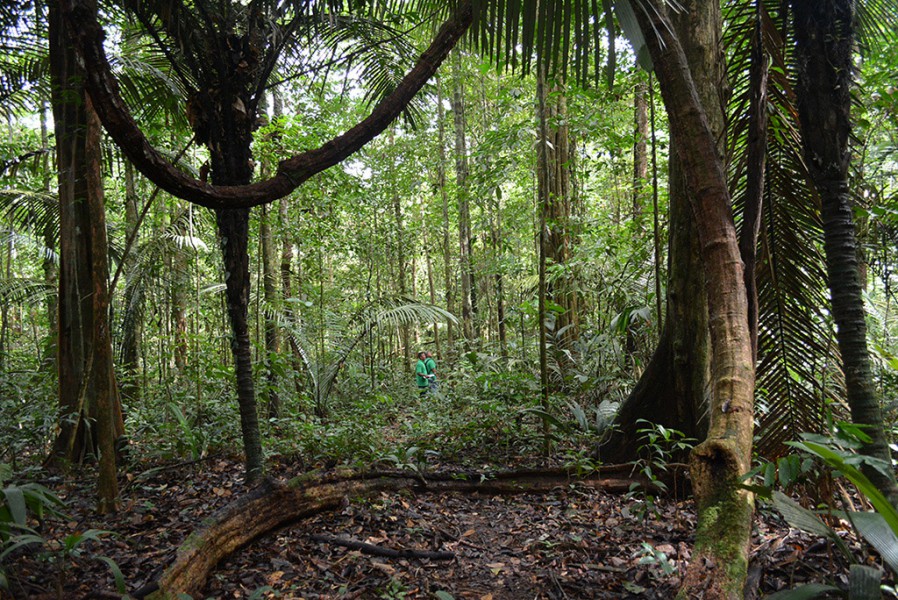
Suriname rainforest. Photo courtesy of the Amazon Conservation Team.
Since the 1960s, development and resource extraction incursions into the country’s interior have become commonplace. These encroachments have taken the form of dam-building, logging, bauxite mining, and as of the turn of the century, small-scale and industrial gold mining, the report says. Given that it is one of the world’s smallest countries, Suriname’s annual rate of gold production might not compare to that of larger countries like South Africa, China, Russia or Peru. But relative to its land area, Suriname actually ranks tenth in global gold production.
Partially republished with permission of Mongabay. Read the full article, Gold mining explodes in Suriname, puts forests and people at risk.
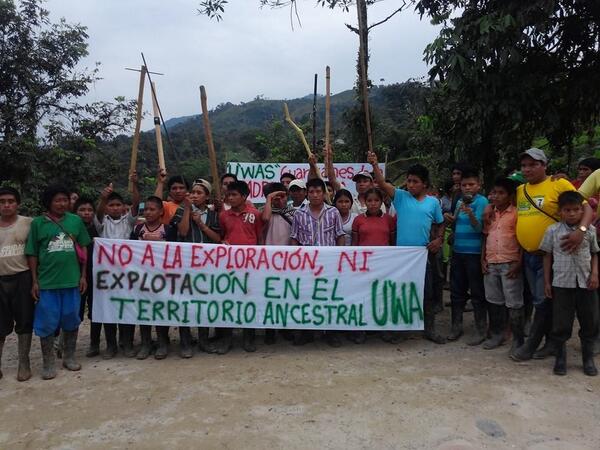
by DGR Colorado Plateau | Oct 21, 2015 | Indigenous Autonomy, Lobbying, Mining & Drilling
CASE ON INDIGENOUS LAND RIGHTS AND EXTRACTIVE PROJECTS MOVES FORWARD AT INTER-AMERICAN COMMISSION ON HUMAN RIGHTS
Washington, DC – The U’wa Nation has received an admissibility report by the Inter-American Commission on Human Rights allowing its case against Colombia to move forward, recognizing that the indigenous group can seek the Commission’s help in defending its traditional territory. Although the U’wa have successfully defeated multiple oil and gas projects in the nearly two decades since they first filed their complaint with the Commission, the report recognizes that winning these battles does not end the overall complaint with the Colombian government, which does not fully recognize the U’wa people’s rights to their territory.
In a statement released [on Oct. 16], The U’wa organization Asou’wa said: “Our U’wa Nation has been heard by the natural law, our ancestors and gods that guide and govern our thinking to safeguard, protect and care for our mother earth; While there are U’wa people, we will continue resisting in defense of our ancient rights.” EarthRights International (ERI) has been supporting Aura Tegria Cristancho, an U’wa lawyer who has been working on the case since 2013 from its offices in Lima, Peru, and Washington, DC.
Asou’wa, supported by the National Indigenous Organization of Colombia and the Coalition for Amazonian Peoples and Their Environment, first filed their complaint with the Commission in 1997. At the time, US-based Occidental Petroleum (Oxy) was threatening to drill for oil in their lands. The U’wa, supported by a global campaign against Oxy led by groups such as Amazon Watch and the Rainforest Action Network, secured Oxy’s withdrawal in 2001. More recently, Colombia’s Ecopetrol tried to move forward with a gas project on U’wa land, but pulled out earlier this year. However, U’wa’s title over their ancestral lands have not been yet recognized.
The Commission’s decision comes after the U’wa and their supporters made it clear that, despite these victories, the root of the problem is the government’s lack of recognition and protection of the indigenous group’s ancestral territory.
“With this decision, the Commission recognized that even though Oxy and Ecopetrol pulled out, the U’wa remain threatened by the failure to fully protect their homeland,” said Camila Mariño, a Colombian lawyer and legal fellow with EarthRights International. “We are proud to stand with the U’wa.”
In the decision, dated July 22 but only released [now], the Commission formally accepts the U’wa petition as “admissible.” According to the Commission’s website, only twelve cases have been accepted as admissible so far this year. Following this decision, the case will move to the “merits” stage, in which the Commission will rule on the rights violations at issue.
– 30 –
Contact:
Valentina Stackl
+1 (202) 466 5188 x 100
valentina@earthrights.org
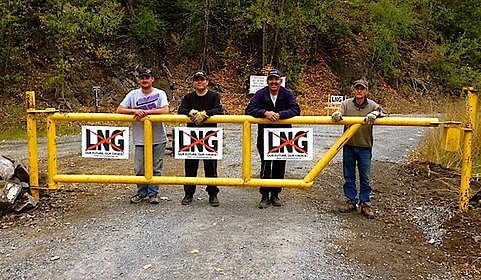
by DGR Colorado Plateau | Oct 18, 2015 | Indigenous Autonomy, Lobbying, Mining & Drilling
VANCOUVER – Luutkudziiwus, a Gitxsan Nation House Group, will file a legal challenge in regard to the BC regulatory permits awarded to the Prince Rupert Gas Transmission (PRGT) pipeline that would supply gas to the Petronas LNG plant on Lelu Island which threatens to decimate Skeena River wild salmon. Luutkudziiwus Hereditary Chiefs travelled down to Vancouver to make the announcement today, while government and industry are gathered at the 2015 LNG Conference in BC.
“We are taking the government to court over the lack of consultation, inadequate baseline information presented, a weak and subjective impact assessment, and the current cumulative effects from past development. People from all over northern BC are now outraged about the $40 billion Petronas LNG project. It is unbelievable that they claim they consulted with us,” says Luutkudziiwus spokesperson Richard Wright.
TransCanada’s proposed 900 km PRGT pipeline, contracted under Petronas, is slated to cross 34 km of Luutkudziiwus traditional Madii Lii territory on its way from massive fracking operations in Treaty 8 territory to the proposed Petronas-led (Pacific Northwest) LNG plant on Lelu Island in the Skeena estuary. Lelu Island is the tribal territory of the Gitwilgyoots of Lax Kw’alaams.
“Our Madii Lii territory is not to be played with by the province of BC in their LNG game. Clark’s LNG dream is a nightmare for us. While she tries to maintain a shiny picture of LNG in their conference this week, the reality is that First Nations are being bulldozed, and we have had enough,” says Hereditary Chief Luutkudziiwus (Charlie Wright).
Luutkudziiwus will ask BC Supreme Court to quash the Environmental Assessment Certificate and the BC Oil and Gas Commission permit to construct and operate the PRGT pipeline. These permits were not based on any substantive consultation, infringe upon Luutkudziiwus’ rights and title by allowing a pipeline which will cause adverse effects to fish and their habitats, wildlife and their habitats, terrestrial and aquatic resources, including cumulative effects, as well as to social, cultural, and economic values. In bringing their lawsuit, Luutkudziiwus is looking for consultation from BC government and will also ask the court to direct the Province of BC to consult with them before any permits are issued.
“The province has been stealing from our territory and culture for 150 years, and this needs to end. The proposed pipeline and LNG project is in deep conflict with core Luutkudziiwus interests and values,” said Hereditary Chief Xsim Wits’iin (Lester Moore).
“We want the BC government to respect our constitutionally protected Aboriginal rights with a true reconciliation process that honors healthy families and increases community health and education. Development within our traditional territories must have our Free, Prior and Informed Consent and stop tearing apart our communities” says Luutkudziiwus spokesperson Pansy Wright.
A delegation from Luutkudziiwus will be in Vancouver on Oct 14th, and will be available for interviews downtown or near the Vancouver Convention Centre on request.
– 30 –
For more information, photos, or to arrange interviews, please contact:
Richard Wright
Luutkudziiwus spokesperson
250.842.8974
richardwright_8@hotmail.com
Greg Horne
Media coordination
250 634 1021
Mary Macaulay
Legal Counsel
604 899 5227
mlmacauly@emlawyers.ca

by DGR Editor | Oct 10, 2015 | Mining & Drilling
by Kim Hill
Ten things environmentalists need to know about renewable energy:
1. Solar panels and wind turbines aren’t made out of nothing. They are made out of metals, plastics, chemicals. These products have been mined out of the ground, transported, processed, manufactured. Each stage leaves behind a trail of devastation: habitat destruction, water contamination, colonization, toxic waste, slave labour, greenhouse gas emissions, wars, and corporate profits. Renewables can never replace fossil fuel infrastructure, as they are entirely dependent on it for their existence.
2. The majority of electricity that is generated by renewables is used in manufacturing, mining, and other industries that are destroying the planet. Even if the generation of electricity were harmless, the consumption certainly isn’t. Every electrical device, in the process of production, leaves behind the same trail of devastation. Living communities—forests, rivers, oceans—become dead commodities.
3. The aim of converting from conventional power generation to renewables is to maintain the very system that is killing the living world, killing us all, at a rate of 200 species per day. Taking carbon emissions out of the equation doesn’t make it sustainable. This system needs not to be sustained, but stopped.
4. Humans, and all living beings, get our energy from plants and animals. Only the industrial system needs electricity to survive, and food and habitat for everyone are being sacrificed to feed it. Farmland and forests are being taken over, not just by the infrastructure itself, but by the mines, processing and waste dumping that it entails. Ensuring energy security for industry requires undermining energy security for living beings (that’s us).
5. Wind turbines and solar panels generate little, if any, net energy (energy returned on energy invested). The amount of energy used in the mining, manufacturing, research and development, transport, installation, maintenance and disposal of these technologies is almost as much—or in some cases more than—they ever produce. Renewables have been described as a laundering scheme: dirty energy goes in, clean energy comes out. (Although this is really beside the point, as no matter how much energy they generate, it doesn’t justify the destruction of the living world.)
6. Renewable energy subsidies take taxpayer money and give it directly to corporations. Investing in renewables is highly profitable. General Electric, BP, Samsung, and Mitsubishi all profit from renewables, and invest these profits in their other business activities. When environmentalists accept the word of corporations on what is good for the environment, something has gone seriously wrong.
7. More renewables doesn’t mean less conventional power, or less carbon emissions. It just means more power is being generated overall. Very few coal and gas plants have been taken off line as a result of renewables.
8. Only 20 per cent of energy used globally is in the form of electricity. The rest is oil and gas. Even if all the world’s electricity could be produced without carbon emissions (which it can’t), it would only reduce total emissions by 20 per cent. And even that would have little impact, as the amount of energy being used globally is increasing exponentially.
9. Solar panels and wind turbines last around 20-30 years, then need to be disposed of and replaced. The production process, of extracting, polluting, and exploiting, is not something that happens once, but is continuous and expanding.
10. The emissions reductions that renewables intend to achieve could be easily accomplished by improving the efficiency of existing coal plants, at a much lower cost. Given that coal or gas plants are required for back-up of all intermittent renewables, this shows that the whole renewables industry is nothing but an exercise in profiteering with no benefits for anyone other than the investors.
Further Reading:
Green Technology and Renewable Energy
Ten Reasons Intermittent Renewables (Wind and Solar PV) are a Problem
The Myth of Renewable Energy
A Problem With Wind Power
Green Illusions: The Dirty Secrets of Clean Energy and the Future of Environmentalism
In China, the true cost of Britain’s clean, green wind power experiment: Pollution on a disastrous scale
Originally published on Stories of Creative Ecology
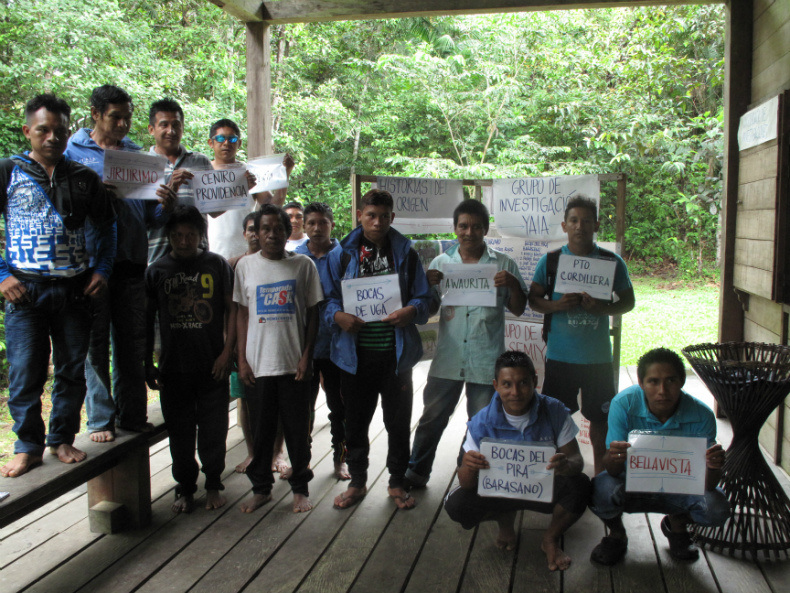
by DGR Colorado Plateau | Oct 9, 2015 | Indigenous Autonomy, Lobbying, Mining & Drilling
By Hannibal Rhoades / Intercontinental Cry
After five years of legal contests and uncertainty, the Colombian Constitutional Court has confirmed that Yaigojé Apaporis, an indigenous resguardo (a legally recognized, collectively owned territory), also has legitimate status as a national park.
The decision is cause for celebration for Indigenous Peoples who call the region home. But it is less welcome news for Canadian multinational mining corporation Cosigo Resources, the company contesting the area’s national park status. The court’s ruling immediately and indefinitely suspends all mining activities in the park, including Cosigo’s license to mine gold from one of Yaigojé’s most sacred areas.
In the broader context of Colombia’s push to expand mining activities in the name of development, the court’s decision is seen as a significant precedent.
Since the 1980s, Colombia has protected more than 24 million hectares of the Amazon, placing an area the size of Britain back in the hands of its traditional owners. By choosing the rights of Indigenous Peoples and a new national park over multinational mining interests, the court’s decision safeguards Colombia’s achievements rather than undermining them.
THE BATTLE FOR YUISI’S GOLDEN LENS
Straddling Amazonas and Vaupés states, comprising a million hectares of the Northwestern Colombian Amazon, the pristine forest region of Yaigojé Apaporis is rich in both biological and cultural diversity.
The area hosts endangered mammals such as the giant anteater, jaguar, manatee and pink river dolphin. It is also home to the Makuna, Tanimuka, Letuama, Barasano, Cabiyari, Yahuna and Yujup-Maku Indigenous Peoples, who share a common cosmological system and rich shamanistic traditions. Together these populations act as Yaigojé’s guardians, a role that was strengthened in 1988 when, with the assistance of Colombian NGO Gaia Amazonas, they successfully established the Yaigojé Apaporis resguardo over their traditional territory. But this status has recently been tested.
Under Colombian law, a resguardo recognition grants its inhabitants collective ownership of and rights to the soil, but the subsoil remains in the control of the state and vulnerable to prospecting. With companies seeking to exploit this loophole, the Colombian Amazon has seen a tidal wave of mining interest since the mid-2000s, with the government declaring mining an “engine for development.”
Riding at the crest of this wave, in the late 2000s Canadian mining multinational Cosigo Resources made clear to local communities in Yaigojé its intention to mine for gold at a site within the resguardo known as La Libertad or Yuisi.
Local indigenous leaders say Cosigo became known to them when company representatives visited their malocas (traditional riverside houses). The indigenous leaders allege that officials offered them money in return for assurance of support the company to mine in Yuisi. These offers were rejected.
At Yuisi, a wide stretch of the Apaporis river cascades over rocks, forming roaring rapids. To the people of Yaigojé it is a vital sacred site, inextricably tied to their story of origin, identity and ability to care for the territory and the planet as a whole. Elders say “Yuisi is the crib of our way of thinking, of life and power. Everything is born here in thought: nature, the crops, trees, fruits, everything that exists, exists before in thought.”
Local shaman describe the gold and other minerals that form the bedrock of their territory as ‘lenses’ that allow them to see into the Earth, divine or diagnose any problems and correct them through rituals, prayer and thought. If gold were to be removed from Yuisi, they would lose their ability to cure and manage their territory as they have done for millennia. This is because an integral part of the territory itself would be lost. The notion that territory stops at the soil “as deep as the manioc’s root” is alien.
With negotiation with Cosigo out of the question, the traditional authorities in Yaigojé called an urgent congress of the Asociación de Capitanes Indígenas del Yaigojé Apaporis (ACIYA), an indigenous organization formed of groups living along the Apaporis River, in the area of Yaigojé that lies in Amazonas State. Having discussed the dangers posed by Cosigo’s presence and plans, ACIYA agreed that they must seek help from outside sources to further protect their territory.
“The best way to shield the territory was to call upon the state. In other words: Western disease is cured by Western medicine. If all mining licenses are given by the state, it is necessary to call on the state to defend the territory,” says Gerardo Macuna, a representative of ACIYA.
Advised that achieving national park status would extend protection to the subsoil, ACIYA and its supporters formally requested that the Colombian Government create a national park over their resguardo and traditional territory.
The people’s effort to add a third layer of protection for their territory was successful. In October 2009, Yaigojé Apaporis became Colombia’s 55th national protected area, but celebrations were short lived. Just two days after the area was awarded national park status, Cosigo Resources was granted a mining title for the Yuisi area, catalysing an epic struggle between Colombia’s will to protect the Amazon, with the help of indigenous inhabitants, or exploit it at their expense by prioritizing mining.
DEEP IN THE AMAZON, A SMOKING GUN

Despite having been granted a license, Yaigojé’s new status as a national park remained an obstacle to Cosigo. The national park status, and its accompanying legal protections for the subsoil, would need to be revoked before mining could begin.
Facing stiff opposition from both ACIYA and the Colombian National Parks authorities just as Cosigo appeared to be fighting an uphill battle, the company got what seemed an almost impossible stroke of luck. A few months after Yaigojé was declared a national park, members of indigenous organization ACITAVA from the region of Yaigojé lying in Vaupés State launched a legal challenge to Yaigojé’s status at the Colombian Constitutional Court. Led by a local settler named Benigno Perilla, the challengers said that they had not been fully or adequately consulted in the process of creating the national park and it therefore violated their right to Free Prior and Informed Consent.
With an apparently complex conflict unfolding between Yaigojé’s Indigenous Peoples and the area’s national park status–its ecological and social integrity held in the balance–a legal deadlock ensued. This situation persisted for three years, until January 2014, when in an unprecedented move, three judges from Colombia’s Constitutional Court made the decision to travel to the heart of the Colombian Amazon to hold a hearing and consult with communities first hand.
Jorge Iván Palacio, president of the court, explained the court’s decision to make the journey by stating that “there is no justice unless we know what they think in the communities.” The ensuing hearing thoroughly vindicated his observation.
Before 160 indigenous inhabitants from along the Apaporis River and the judges, Benigno Perilla publicly admitted that his and ACITAVA’s legal strategy was encouraged, organized and paid for by Cosigo Resources. In what would prove the critical turning point in the case, the indigenous members of ACITAVA who had supported the challenge made a public apology, said they had been misled and declared their support for the creation of the national park.
A NEW DAWN FOR INDIGENOUS-LED CONSERVATION
Although it has been more than another year coming, the Colombian Constitutional Court has ousted Cosigo and legitimized the declaration of Yaigojé Apaporis as a national park. The decision recognizes the authority of the area’s Indigenous Peoples and protects their fundamental rights to culture, identity and consultation.
The decision is regarded as a significantly positive precedent for future conflicts between mining operations, protected areas and their indigenous inhabitants, at a time when Colombia has declared mining to be in the national interest.
The judges found sufficient evidence of wrongdoing by Cosigo to ask Colombia’s Justice Minister to open an investigation into the company’s consultation processes and interactions with communities in the Yaigojé area. Recently published revisions to Colombia’s projects of national interest have seen Cosigo’s project removed from the list. The company is said to be reviewing its legal options.
Confirming the compatibility of indigenous resguardos and national parks, the court has also opened up the possibility for others to follow Yaigojé’s example and enhance the protection of their territories from destructive or unwanted “development.”
Since Yaigojé was declared a national park, and in spite of the legal wrangle over its future, ACIYA and local indigenous youths have been pioneering a powerful new conservation paradigm that values indigenous knowledge and places it at the root of national park management.
ACIYA’s work to find a method of conservation that both works for them and allows for close collaboration with Colombia’s national park authorities is the subject of a recent film and won the group the prestigious UNDP Equator Prize in 2014. Their approach stands in stark contrast to technocratic, neo-colonialist conservation norms founded on a misplaced belief in pristine, unmanaged wilderness. These have been criticized by Indigenous Peoples and rights groups for excluding and forcibly displacing indigenous communities, fencing them out of their own lands and so obstructing their right to practice their cultures.
As part of their program, 27 young indigenous leaders from nine communities in Yaigojé have engaged in a deep process of cultural research. Advised by their elders, they have documented, mapped and recorded their peoples’ traditional practices for safeguarding and conserving the forest. In the words of one researcher, the aim has been to “transmit traditional knowledge to the younger generations and protect our ancestral territory.” So far, they have succeeded in doing both.
The research produced by ACIYA will now be used to define the management of the Yaigojé Apaporis National Park, further legitimizing local indigenous knowledge systems that have protected the life-support capacities of this rainforest region for generation after generation.
“Indigenous people are the natural allies of the rainforest and the whole environmental movement,” says former director of Gaia Amazonas Martin Von Hildebrand. “They have the traditional knowledge, they are organized. We just need to support them with what they need to run their own territories.”











